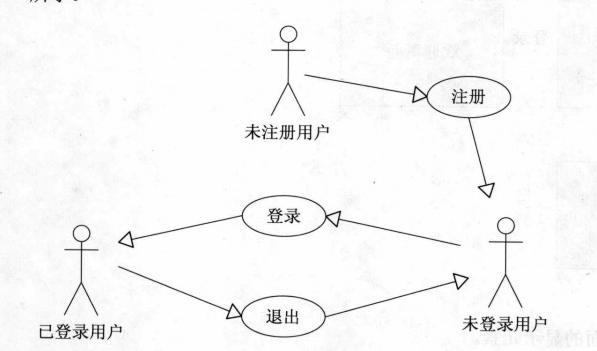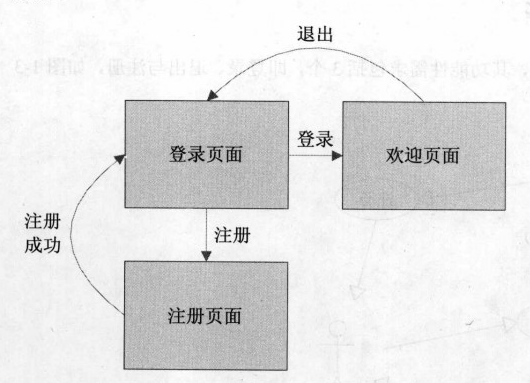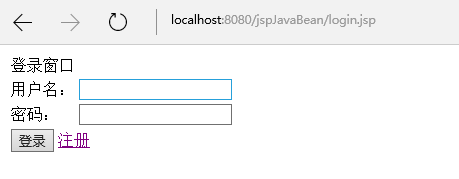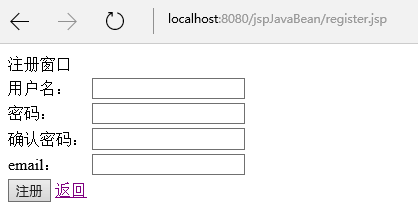本文講述使用JSP實現用戶登錄,包括用戶登錄、注冊和退出功能等。
1.系統用例圖

2.頁面流程圖

3.數據庫設計
本例使用oracle數據庫
創建用戶表
包括id,username,password和email,共4個字段
-- Create table
create table P_USER
(
id VARCHAR2(50) not null,
username VARCHAR2(20),
password VARCHAR2(20),
email VARCHAR2(50)
)
tablespace USERS
pctfree 10
initrans 1
maxtrans 255
storage
(
initial 64
minextents 1
maxextents unlimited
);
-- Add comments to the table
comment on table P_USER
is '用戶表';
-- Add comments to the columns
comment on column P_USER.id
is 'id';
comment on column P_USER.username
is '用戶名';
comment on column P_USER.password
is '密碼';
comment on column P_USER.email
is 'email';
4.頁面設計
4.1登錄頁面
login.jsp
%@ page language="java" import="java.util.*" pageEncoding="UTF-8"%>
%
String path = request.getContextPath();
String basePath = request.getScheme()+"://"+request.getServerName()+":"+request.getServerPort()+path+"/";
%>
!DOCTYPE HTML PUBLIC "-//W3C//DTD HTML 4.01 Transitional//EN">
html>
head>
base href="%=basePath%>">
title>登錄頁面/title>
meta http-equiv="pragma" content="no-cache">
meta http-equiv="cache-control" content="no-cache">
meta http-equiv="expires" content="0">
meta http-equiv="keywords" content="keyword1,keyword2,keyword3">
meta http-equiv="description" content="This is my page">
!--
link rel="stylesheet" type="text/css" href="styles.css">
-->
/head>
body>
form action="login_action.jsp" method="post">
table>
tr>
td colspan="2">登錄窗口/td>
/tr>
tr>
td>用戶名:/td>
td>input type="text" name="username" />
/td>
/tr>
tr>
td>密碼:/td>
td>input type="text" name="password" />
/td>
/tr>
tr>
td colspan="2">input type="submit" value="登錄" /> a href="register.jsp">注冊/a>
/td>
/tr>
/table>
/form>
/body>
/html>
頁面效果

4.2登錄邏輯處理頁面
login_action.jsp
%@ page language="java" import="java.util.*" pageEncoding="utf-8"%>
%@ page import="java.sql.*" %>
%
String path = request.getContextPath();
String basePath = request.getScheme()+"://"+request.getServerName()+":"+request.getServerPort()+path+"/";
%>
%
String username = request.getParameter("username");
String password = request.getParameter("password");
if(username==null||"".equals(username.trim())||password==null||"".equals(password.trim())){
//out.write("用戶名或密碼不能為空!");
System.out.println("用戶名或密碼不能為空!");
response.sendRedirect("login.jsp");
return;
//request.getRequestDispatcher("login.jsp").forward(request, response);
}
boolean isValid = false;
Connection con = null;// 創建一個數據庫連接
PreparedStatement pre = null;// 創建預編譯語句對象,一般都是用這個而不用Statement
ResultSet result = null;// 創建一個結果集對象
try
{
Class.forName("oracle.jdbc.driver.OracleDriver");// 加載Oracle驅動程序
//System.out.println("開始嘗試連接數據庫!");
String url = "jdbc:oracle:" + "thin:@127.0.0.1:1521:orcl";// 127.0.0.1是本機地址,orcl是Oracle的默認數據庫名
String user = "scott";// 用戶名,系統默認的賬戶名
String pwd = "tiger";// 你安裝時選設置的密碼
con = DriverManager.getConnection(url, user, pwd);// 獲取連接
// System.out.println("連接成功!");
String sql = "select * from p_user where username=? and password=?";// 預編譯語句,“?”代表參數
pre = con.prepareStatement(sql);// 實例化預編譯語句
pre.setString(1, username);// 設置參數,前面的1表示參數的索引,而不是表中列名的索引
pre.setString(2, password);// 設置參數,前面的1表示參數的索引,而不是表中列名的索引
result = pre.executeQuery();// 執行查詢,注意括號中不需要再加參數
if (result.next()){
isValid = true;
}
}
catch (Exception e)
{
e.printStackTrace();
}
finally
{
try
{
// 逐一將上面的幾個對象關閉,因為不關閉的話會影響性能、并且占用資源
// 注意關閉的順序,最后使用的最先關閉
if (result != null)
result.close();
if (pre != null)
pre.close();
if (con != null)
con.close();
//System.out.println("數據庫連接已關閉!");
}
catch (Exception e)
{
e.printStackTrace();
}
}
if(isValid){
System.out.println("登錄成功!");
session.setAttribute("username", username);
response.sendRedirect("welcome.jsp");
return;
}else{
System.out.println("登錄失敗!");
response.sendRedirect("login.jsp");
return;
}
%>
使用JDBC連接數據庫,如果用戶名或密碼為空時,還是跳轉到登錄頁面login.jsp
如果用戶名和密碼不為空,進行連接數據庫查詢用戶表,如果能夠查詢到記錄,表示登錄成功,將用戶信息保存到session,跳轉到歡迎頁面welcome.jsp
如果根據用戶名和密碼查詢不到記錄,表示登錄失敗,重新跳轉到登錄頁面login.jsp
4.3歡迎頁面
welcome.jsp
%@ page language="java" import="java.util.*" pageEncoding="UTF-8"%>
%
String path = request.getContextPath();
String basePath = request.getScheme()+"://"+request.getServerName()+":"+request.getServerPort()+path+"/";
%>
!DOCTYPE HTML PUBLIC "-//W3C//DTD HTML 4.01 Transitional//EN">
html>
head>
base href="%=basePath%>">
title>My JSP 'welcom.jsp' starting page/title>
meta http-equiv="pragma" content="no-cache">
meta http-equiv="cache-control" content="no-cache">
meta http-equiv="expires" content="0">
meta http-equiv="keywords" content="keyword1,keyword2,keyword3">
meta http-equiv="description" content="This is my page">
!--
link rel="stylesheet" type="text/css" href="styles.css">
-->
/head>
body>
table>
tr>
td>img src="images/logo4.png" />
/td>
td>img src="images/logo2.png" height="90" />
/td>
/tr>
tr>
td colspan="2">hr />
/td>
/tr>
tr>
td>
table>
tr>
td>a>Main/a>
/td>
/tr>
tr>
td>a>Menu1/a>
/td>
/tr>
tr>
td>a>Menu2/a>
/td>
/tr>
tr>
td>a>Menu3/a>
/td>
/tr>
tr>
td>a>Menu4/a>
/td>
/tr>
tr>
td>a>Menu5/a>
/td>
/tr>
tr>
td>a>Menu6/a>
/td>
/tr>
tr>
td>a>Menu7/a>
/td>
/tr>
tr>
td>a>Menu8/a>
/td>
/tr>
/table>/td>
td>
form action="loginout.jsp" method="post">
table>
tr>
td colspan="2">登錄成功!/td>
/tr>
tr>
td>歡迎你,/td>
td>${username }/td>
/tr>
tr>
td colspan="2">input type="submit" value="退出" />/td>
/tr>
/table>
/form>/td>
/tr>
/table>
/body>
/html>
使用EL表達式展示用戶信息
效果

4.4歡迎頁退出邏輯處理頁面
loginout.jsp
%@ page language="java" import="java.util.*" pageEncoding="UTF-8"%>
%
String path = request.getContextPath();
String basePath = request.getScheme()+"://"+request.getServerName()+":"+request.getServerPort()+path+"/";
%>
!DOCTYPE HTML PUBLIC "-//W3C//DTD HTML 4.01 Transitional//EN">
html>
head>
base href="%=basePath%>">
title>My JSP 'loginout.jsp' starting page/title>
meta http-equiv="pragma" content="no-cache">
meta http-equiv="cache-control" content="no-cache">
meta http-equiv="expires" content="0">
meta http-equiv="keywords" content="keyword1,keyword2,keyword3">
meta http-equiv="description" content="This is my page">
!--
link rel="stylesheet" type="text/css" href="styles.css">
-->
/head>
body>
%
session.removeAttribute("username");
response.sendRedirect("login.jsp");
%>
/body>
/html>
將session的用戶信息移除,跳轉到登錄頁面login.jsp
4.5注冊頁面
register.jsp
%@ page language="java" import="java.util.*" pageEncoding="UTF-8"%>
%
String path = request.getContextPath();
String basePath = request.getScheme()+"://"+request.getServerName()+":"+request.getServerPort()+path+"/";
%>
!DOCTYPE HTML PUBLIC "-//W3C//DTD HTML 4.01 Transitional//EN">
html>
head>
base href="%=basePath%>">
title>注冊頁面/title>
meta http-equiv="pragma" content="no-cache">
meta http-equiv="cache-control" content="no-cache">
meta http-equiv="expires" content="0">
meta http-equiv="keywords" content="keyword1,keyword2,keyword3">
meta http-equiv="description" content="This is my page">
!--
link rel="stylesheet" type="text/css" href="styles.css">
-->
/head>
body>
form action="register_action.jsp" method="post">
table>
tr>
td colspan="2">注冊窗口/td>
/tr>
tr>
td>用戶名:/td>
td>input type="text" name="username" />/td>
/tr>
tr>
td>密碼:/td>
td>input type="text" name="password1" />/td>
/tr>
tr>
td>確認密碼:/td>
td>input type="text" name="password2" />/td>
/tr>
tr>
td>email:/td>
td>input type="text" name="email" />/td>
/tr>
tr>
td colspan="2">input type="submit" value="注冊" /> a href="login.jsp">返回/a>/td>
/tr>
/table>
/form>
/body>
/html>
當在登錄頁面點擊“注冊“時打開用戶注冊頁面
效果

4.6注冊邏輯處理頁面
register_action.jsp
%@ page language="java" import="java.util.*" pageEncoding="UTF-8"%>
%@ page import="java.sql.*" %>
%
String path = request.getContextPath();
String basePath = request.getScheme()+"://"+request.getServerName()+":"+request.getServerPort()+path+"/";
%>
%
String username = request.getParameter("username");
String password1 = request.getParameter("password1");
String password2 = request.getParameter("password2");
String email = request.getParameter("email");
if(username==null||"".equals(username.trim())||password1==null||"".equals(password1.trim())||password2==null||"".equals(password2.trim())||!password1.equals(password2)){
//out.write("用戶名或密碼不能為空!");
System.out.println("用戶名或密碼不能為空!");
response.sendRedirect("register.jsp");
return;
//request.getRequestDispatcher("login.jsp").forward(request, response);
}
boolean isValid = false;
Connection con = null;// 創建一個數據庫連接
PreparedStatement pre = null;// 創建預編譯語句對象,一般都是用這個而不用Statement
ResultSet result = null;// 創建一個結果集對象
try
{
Class.forName("oracle.jdbc.driver.OracleDriver");// 加載Oracle驅動程序
//System.out.println("開始嘗試連接數據庫!");
String url = "jdbc:oracle:" + "thin:@127.0.0.1:1521:orcl";// 127.0.0.1是本機地址,orcl是Oracle的默認數據庫名
String user = "scott";// 用戶名,系統默認的賬戶名
String pwd = "tiger";// 你安裝時選設置的密碼
con = DriverManager.getConnection(url, user, pwd);// 獲取連接
//System.out.println("連接成功!");
String sql = "select * from p_user where username=?";// 預編譯語句,“?”代表參數
pre = con.prepareStatement(sql);// 實例化預編譯語句
pre.setString(1, username);// 設置參數,前面的1表示參數的索引,而不是表中列名的索引
result = pre.executeQuery();// 執行查詢,注意括號中不需要再加參數
if (!result.next()){
sql = "insert into p_user(id,username,password,email) values(?,?,?,?)";// 預編譯語句,“?”代表參數
pre = con.prepareStatement(sql);// 實例化預編譯語句
pre.setString(1, System.currentTimeMillis()+"");// 設置參數,前面的1表示參數的索引,而不是表中列名的索引
pre.setString(2, username);// 設置參數,前面的1表示參數的索引,而不是表中列名的索引
pre.setString(3, password1);// 設置參數,前面的1表示參數的索引,而不是表中列名的索引
pre.setString(4, email);// 設置參數,前面的1表示參數的索引,而不是表中列名的索引
pre.executeUpdate();// 執行
isValid = true;
}
}
catch (Exception e)
{
e.printStackTrace();
}
finally
{
try
{
// 逐一將上面的幾個對象關閉,因為不關閉的話會影響性能、并且占用資源
// 注意關閉的順序,最后使用的最先關閉
if (result != null)
result.close();
if (pre != null)
pre.close();
if (con != null)
con.close();
//System.out.println("數據庫連接已關閉!");
}
catch (Exception e)
{
e.printStackTrace();
}
}
if(isValid){
System.out.println("注冊成功,請登錄!");
response.sendRedirect("login.jsp");
return;
}else{
System.out.println("用戶名已存在!");
response.sendRedirect("register.jsp");
return;
}
%>
首先判斷用戶名和密碼是否為空,以及密碼和確認密碼是否一致,如果上述條件不成立時,返回到注冊頁面register.jsp
如果上述條件成立,就根據用戶名到數據庫查詢,如果能夠查詢到記錄,說明用戶名已經存在,返回到注冊頁面register.jsp
如果查詢不到記錄,說明此用戶名可用來進行注冊,使用JDBC向用戶表 插入1條記錄;之后跳轉到登錄頁面login.jsp
5.總結
本例使用JSP實現用戶登錄,編寫過程中,主要遇到了2個小問題。
5.1查詢之后,判斷記錄是否存在,需要使用 if (!result.next()),而不是通常查詢中使用的while循環,這一點需要注意,特別是在處理注冊時。
5.2關于JSP頁面的編譯報錯問題。
當在JSP小腳本中中使用return時要慎重,很可能會出現編譯錯誤。
處理方法是,JSP主頁面只使用JSP小腳本,保證return之后沒有還需要編譯的內容即可。
以上即為使用JSP實現用戶登錄的簡單介紹,希望對大家的學習有所幫助。
您可能感興趣的文章:- jsp+dao+bean+servlet(MVC模式)實現簡單用戶登錄和注冊頁面
- 使用JSP實現簡單的用戶登錄注冊頁面示例代碼解析
- jsp實現用戶自動登錄功能
- jsp實現簡單用戶7天內免登錄
- servlet+jsp實現過濾器 防止用戶未登錄訪問
- JSP Spring防止用戶重復登錄的實現方法
- JavaWeb實現用戶登錄注冊功能實例代碼(基于Servlet+JSP+JavaBean模式)
- jsp基于XML實現用戶登錄與注冊的實例解析(附源碼)
- JSP實現簡單的用戶登錄并顯示出用戶信息的方法
- 在jsp中用bean和servlet聯合實現用戶注冊、登錄
- 關于JSP用戶登錄連接數據庫詳情